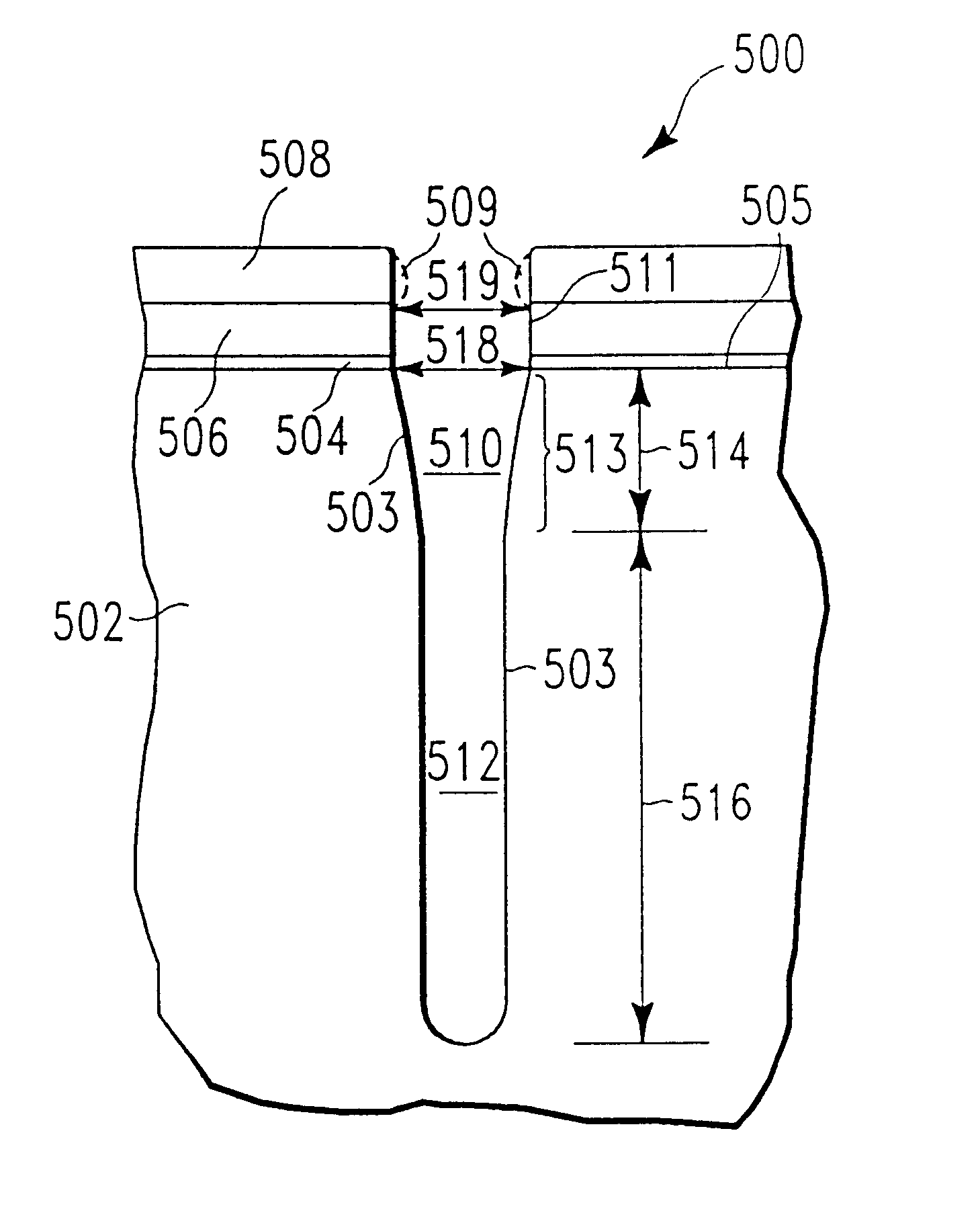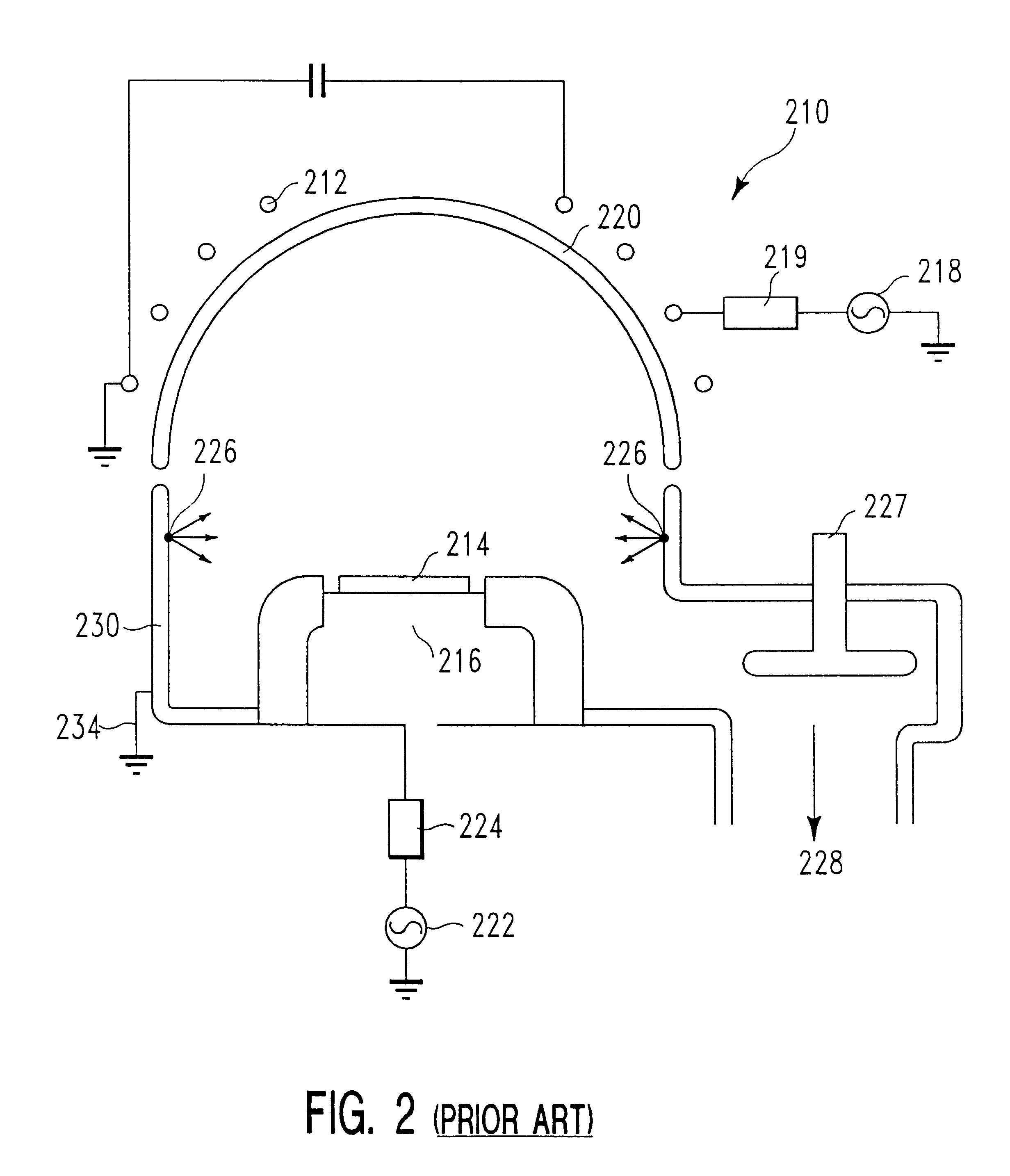Silicon trench etch using silicon-containing precursors to reduce or avoid mask erosion
- Summary
- Abstract
- Description
- Claims
- Application Information
AI Technical Summary
Problems solved by technology
Method used
Image
Examples
example two
The Prior Art Single Step Etch Chemistry and Method
FIG. 4 illustrates a schematic of the cross-sectional profile of a deep etched silicon trench structure 400 obtained by applicants using a single step process of the kind previously known in the art. It was this single step process which was improved upon by applicants in the two step etch process described above in Example One. This example is provided for comparative purposes only.
In particular, the thickness of the borosilicate glass patterning mask 408 after etching of silicon trench 403 was about 1,800 .ANG.; the thickness of silicon nitride masking layer 406 remained at about 2,200 .ANG.; the thickness of pad oxide dielectric layer 404 was about 80 .ANG.. (FIG. 4 is not to scale.) The top portion 410 of the trench 403, which extends from the silicon surface 405 into the silicon substrate 402 a depth 414 of about 1.5 .mu.m is tapered at an angle of about 88.5.+-.0.2.degree.. As a result of the lateral erosion (as illustrated at...
example three
The Single Step Etch Chemistry and Method of the Present Invention
FIG. 5 illustrates a schematic of the cross-sectional profile of a deep etched silicon trench structure 500 obtained in a single etch step using the etch chemistry and method of the present invention.
In particular, the thickness of the borosilicate glass patterning mask 508 after etching of silicon trench 503 was about 5,600 .ANG.; the thickness of silicon nitride masking layer 506 remained at about 2,200 .ANG.; the thickness of pad oxide dielectric layer 504 was about 80 .ANG.. (FIG. 5 is not to scale.) The top portion 510 of the trench 503, extended from the silicon surface 505 into the silicon substrate 502 a depth 514 of about 1.5 .mu.m was tapered at an angle of 88.5.degree..+-.0.5.degree.. The critical dimension 518 was 0.32 .mu.m, which was maintained during etching because silicon nitride masking layer 506 maintained a constant dimension (as shown on the drawing at 519). The bottom portion 512 of the trench 50...
example four
Use of the First Step Etch Chemistry from the Prior Art and the Method of the Present Invention as the Second Step in a Two Step Process
FIG. 6 illustrates a schematic of the cross-sectional profile of a deep etched silicon trench structure 600 obtained by applicants using a two step process of the kind described in U.S. application Ser. No. 08 / 985,771, but substituting the etch chemistry and method of the present invention for the second step in the two step process.
In particular, the thickness of the borosilicate glass patterning mask 608 after etching of silicon trench 603 was about 5,900 .ANG.; the thickness of silicon nitride masking layer 606 remained at about 2,200 .ANG.; the thickness of pad oxide dielectric layer 604 was about 80 .ANG.. (FIG. 6 is not to scale.) The top portion 610 of the trench 603, which extended from the silicon surface 605 into the silicon substrate 602 a depth 614 of about 1.5 .mu.m was tapered at an angle of 88.4.+-.0.3.degree.. The critical dimension ...
PUM
 Login to View More
Login to View More Abstract
Description
Claims
Application Information
 Login to View More
Login to View More - R&D
- Intellectual Property
- Life Sciences
- Materials
- Tech Scout
- Unparalleled Data Quality
- Higher Quality Content
- 60% Fewer Hallucinations
Browse by: Latest US Patents, China's latest patents, Technical Efficacy Thesaurus, Application Domain, Technology Topic, Popular Technical Reports.
© 2025 PatSnap. All rights reserved.Legal|Privacy policy|Modern Slavery Act Transparency Statement|Sitemap|About US| Contact US: help@patsnap.com



